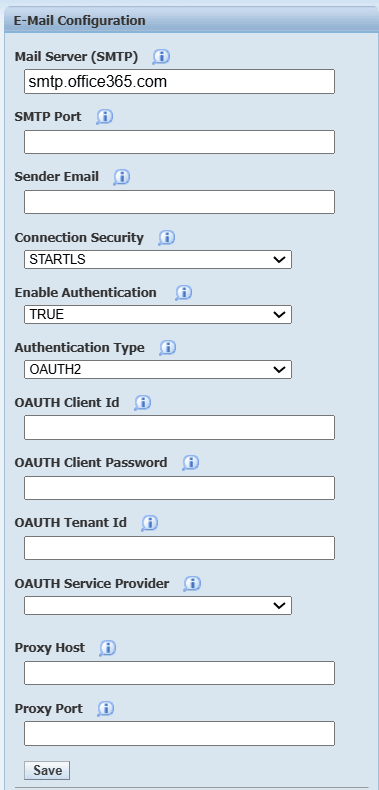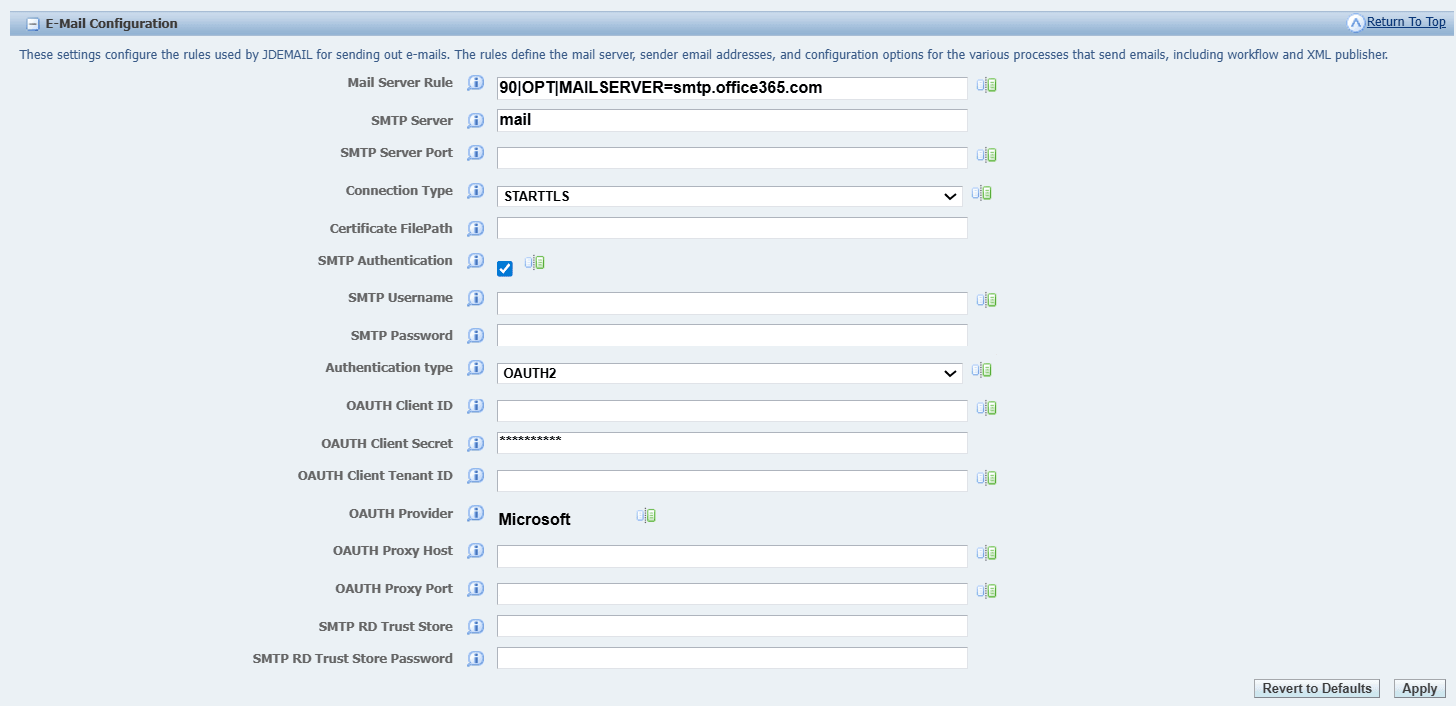Introduction
This Oracle by Example (OBE) describes how to configure the email settings in JD Edwards EnterpriseOne using the latest OAuth2 authentication for SMTP servers.Microsoft has deprecated the basic authentication type for SMTP services. To ensure secure and reliable email delivery, JD Edwards EnterpriseOne now supports OAuth 2.0 authentication. This method uses token-based access instead of storing and transmitting sensitive credentials.
Objectives
In this OBE, you will configure JD Edwards EnterpriseOne to use
Microsoft OAuth 2.0 for outbound email delivery.
You will learn how to:
- Configure the server manager settings to enable the OAuth 2.0 tokens instead of traditional username-password authentication.
- Verify the setup by sending a test email.
Prerequisites
- Access to the Server Manager Console (SMC) and the EnterpriseOne Server configuration files (jde.ini).
- An application registered in Microsoft Entra for SMTP OAuth 2.0 authentication credentials. This registration provides the following credentials:
- OAuth Client ID
- OAuth Client Password
- OAuth Tenant ID
For more information, see Register an application in Microsoft Entra ID.
Task 1: Configuring OAuth 2.0 in Server Manager Console
- Access the JD Edwards EnterpriseOne Server Manager.
- Click the Server Activity link in the What do you want to do? pane. The Management Console displays another pane under What do you want to do? called E-Mail Configuration.
- In the E-Mail Configuration pane, complete the following:
- In Mail Server (SMTP) field, enter
smtp.office365.comas the host. - In the SMTP Port field, enter the TCP/IP port to use when connecting to the SMTP mail server for sending emails.
- In the Sender Email field, enter the email address to use as the sender for email notifications sent by Server Manager.
- From the Connection Security drop-down
list, select a connection type. To describe the steps in this
OBE,
STARTLSconnection is used. - From the Enable Authentication drop-down
list, select
TRUEto enable authentication on the SMTP server. - In the Authentication type field, the default value is set to Basic. Select OAUTH2 from the drop-down list to set it as the authentication type. When you select OAUTH2 as the Authentication type, additional fields for OAuth configuration are displayed, including OAUTH Client Id, OAUTH Client Password, and OAUTH Tenant Id.
- In the OAUTH Client Id field, enter the client ID that you obtained after registering your application in Microsoft Entra.
- In the OAUTH Client Password field, enter the client password that you obtained after registering your application in Microsoft Entra.
- In the OAUTH Tenant Id field, enter the tenant ID that you obtained after registering your application in Microsoft Entra.
- In the OAUTH Service Provider field, select Microsoft as the service provider. Only Microsoft is supported as an OAUTH provider.
- In the Proxy Host field, enter the proxy host to connect to the SMTP server.
- In the Proxy Port field, enter the proxy port to connect to the SMTP server.
- Click Save.
- In the Email Address field that appears at the bottom of the pane, enter a valid recipient email address or multiple email addresses separated by commas.
- Click Test. The recipient receives a test email indicating successful configuration.
Note: You must enter the Proxy Host and Proxy Port field values if your corporate network blocks direct access to Microsoft OAuth servers. Leave these fields blank if your corporate network does not block access to Microsoft OAuth servers.
- In Mail Server (SMTP) field, enter

Task 2: Configuring OAuth 2.0 on the Enterprise Server
- In the Managed Homes pane of the Server Manager Console, click the Enterprise Server instance.
- In the Configuration pane, select Basic from the View drop-down list, and then click the Miscellaneous link.
- In the Miscellaneous pane, go to the E-Mail Configuration and complete the following:
- In the Mail Server Rule, define the rule as
90|OPT|MAILSERVER=smtp.office365.com. - In the SMTP Server Port field, enter the SMTP port number on the mail server machine.
- From the Connection Security drop-down list, select a
connection type. To describe the steps in this OBE,
STARTTLSconnection is used. - Select the SMTP Authentication option.
- In the SMTP Username field, enter the username to authenticate with the SMTP server.
- From the Authentication type drop-down list,
select
OAUTH2as the authentication type. - In the OAUTH Client ID field, enter the client ID that you obtained after registering your application in Microsoft Entra.
- In the OAUTH Client Secret field, enter the client password that you obtained after registering your application in Microsoft Entra.
- In the OAUTH Client Tenant ID field, enter the tenant ID that you obtained after registering your application in Microsoft Entra. The OAUTH Service Provider is displayed as Microsoft by default.
- In the OAUTH Proxy Host field, enter the proxy host to connect to the SMTP server.
- In the OAUTH Proxy Port field, enter the proxy port to connect to the SMTP server.
- Click Apply.
- Restart the Enterprise Server.

Note: You must enter the OAUTH Proxy Host and OAUTH Proxy Port field values if your corporate network blocks direct access to Microsoft OAuth servers. Leave these fields blank if your corporate network does not block access to Microsoft OAuth servers.
To verify the E-Mail configuration, complete the following:
- Access the EnterpriseOne HTML server.
- In the Navigator (Fast Path), enter BV. From the Work With Batch Versions form, select any UBE.
- Submit the selected UBE. The user receives a report completion email to the email address defined in the Who’s Who record associated with the corresponding Address Book number.
Want to Learn More?
More Learning Resources
Explore other labs on docs.oracle.com/learn or access more free learning content on the Oracle Learning YouTube channel. Additionally, visit education.oracle.com/learning-explorer to become an Oracle Learning Explorer.
For product documentation, visit Oracle Help Center.
Configuring OAuth 2.0 Authentication for Outbound Messaging in JD Edwards EnterpriseOne
G44593-01
October 2025
Copyright © 2025, Oracle and/or its affiliates.